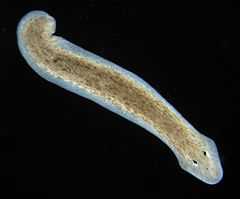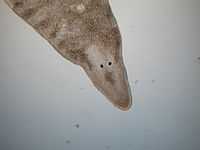Tricladida
| Tricladida | |
|---|---|
 | |
| Dugesia subtentaculata, a dugesiid. | |
| Scientific classification | |
| Kingdom: | Animalia |
| Phylum: | Platyhelminthes |
| Class: | Turbellaria |
| Order: | Tricladida Lang, 1884 |
| Suborders[1] | |
| |
Tricladida (triclads)[2] is an order of turbellarians, a group of free-living flatworms. They are also known as planarians, although this common name is also used for a wide number of free-living platyhelminthes.[3]
The triclads are characterized by triply branched intestine and anteriorly situated ovaries, next to the brain.
Today the order Tricladida is split into three suborders, according to their phylogenetic relationships: Maricola, Cavernicola and Continenticola. Formerly, the Tricladida was split according to habitats: Maricola, which is marine; Paludicola, which inhabits freshwater; and Terricola, which is land-dwelling.[4]
Description
The triclads have a posterior end or head where the eyes and sense organs are found. Some species have auricles that protude from the margins of the head. The auricles can contain chemical and mechanical sensory receptors.[5]
The number of eyes in the triclads is variable depending on the species. While many species have two eyes (e.g. Dugesia or Microplana), others have more. Sometimes, those species with two eyes may present smaller accessory or supernumerary eyes. The subterranean triclads are often eyeless or blind.[5]
The body of the triclads is covered by a ciliated epidermis that contains rhabdites. Between the epidermis and the gastrodermis there is a parenchymatous tissue or mesenchyme.[5]
Reproduction
Many species can use both asexual and sexual reproduction. Most of the triclads are hermaphrodites, the same individual has both male and female sexual organs at the same time. In most of the cases the sexual reproduction involve two individuals, autofecundation has been rarely reported (e.g. in Cura foremanii).[5]
Phylogeny and taxonomy
Phylogeny
Phylogenetic supertree after Sluys et al., 2009:[1]
| Tricladida |
| ||||||||||||||||||||||||||||||||||||
| |
Taxonomy


Linnaean ranks after Sluys et al., 2009:[1]
- Order Tricladida
- Suborder Maricola
- Superfamily Cercyroidea
- Family Centrovarioplanidae
- Family Cercyridae
- Family Meixnerididae
- Superfamily Bdellouroidea
- Family Uteriporidae
- Family Bdellouridae
- Superfamily Procerodoidea
- Family Procerodidae
- Superfamily Cercyroidea
- Suborder Cavernicola[6]
- Family Dimarcusidae
- Suborder Continenticola
- Superfamily Planarioidea
- Family Planariidae
- Family Dendrocoelidae
- Family Kenkiidae
- Superfamily Geoplanoidea
- Family Dugesiidae
- Family Geoplanidae
- Superfamily Planarioidea
- Suborder Maricola
References
- ↑ 1.0 1.1 1.2 Sluys, R.; Kawakatsu, M.; Riutort, M.; Baguñà, J. (2009). "A new higher classification of planarian flatworms (Platyhelminthes, Tricladida)". Journal of Natural History 43 (29–30): 1763–1777. doi:10.1080/00222930902741669.
- ↑ "Tricladida". Integrated Taxonomic Information System. Retrieved July 23, 2007.
- ↑ "Planarian (flatworm) – Britannica Online Encyclopedia". Encyclopædia Britannica, Inc. Retrieved 2010-05-01.
- ↑ Hallez P. (1892). Classification des Ticlades, Bulletin de la Société Zoologique de France.
- ↑ 5.0 5.1 5.2 5.3 Kenk, R., 1972. Freshwater planarians (Turbellarians) of North America.
- ↑ Sluys, R. (1990). "A monograph of the Dimarcusidae (Platyhelminthes, Seriata, Tricladida)". Zoologica Scripta 19 (1): 13–29. doi:10.1111/j.1463-6409.1990.tb00237.x.
External links
| External identifiers for Tricladida | |
|---|---|
| WoRMS | 142028 |
- Tricladida on the Encyclopedia of Life (EOL)
- Land planarians on the UF / IFAS Featured Creatures Web site